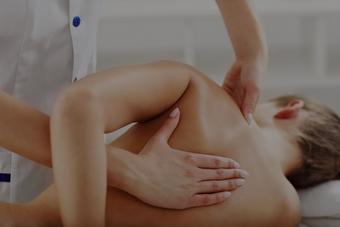What is SMR? Guide to Self-Myofascial Release
If you want to find out more about the self-myofascial release, you’ve certainly landed on the right article.
We’re going to keep it as simple as possible and go through everything step-by-step to avoid bombarding you with huge chunks of information.
If you’re already working within the fitness sector and you’re looking to further your professional development, check out our Level 3 Sports Massage Course and download our latest prospectus for more information!
Do You Want More Sports Massage Clients?
Download our guide and grow your base in 5 simple steps!
What is SMR?
Before we jump into the benefits of self-myofascial release and what it can do for you if you happen to be experiencing muscle soreness yourself, we’re going to answer the question of what is SMR?, especially for those who are unfamiliar with the phrase.
Glossary:
- SMR - self-myofascial release (acronym)
- Fascia - the internal connective tissue beneath the skin that attaches, stabilizes, encloses, and separates muscles and other internal organs
- Trigger point - a sensitive spot located within the muscle or muscle fascia, brought about by injury
SMR (the acronym for self-myofascial release) is a self-massage technique performed by an individual who is experiencing muscle tightness or pain as a result of exercise. It is sometimes used by those who wish to prevent this in the first place as part of their regular warm-up routine.
Self-myofascial release techniques involve the use of tools, most commonly foam rollers, to massage the muscles and the fascia around them that have been affected by pain and tightness.

This is done to release the trigger points within the muscles, also known as ‘muscle knots’, that appear after an individual has sustained an injury to the area. They tend to grow and multiply around injuries overtime, becoming increasingly sensitive, but with regular release this can be prevented and even undone.
SMR is best performed over a larger area of muscle that the trigger points are sitting within, as it can be incredibly difficult to find their exact location. They could be resting within the muscle itself, or the fascia that surrounds the muscle, so it’s a good idea to stick to a holistic area and take things slow!
The muscle soreness that self-myofascial release therapy is usually used to treat is called ‘DOMS’ (delayed onset muscle soreness), which is the pain that we experience in the days after exercise.
It shouldn’t be confused with acute muscle soreness, which is the burning sensation that you experience when contracting a muscle. This is completely normal and happens when there is a swift buildup on lactic acid within the muscle, but usually vanishes shortly after you’ve finished your workout.
DOMS is also extremely common and something that most of us have experienced, but it is a different type of pain, and can even last up to a couple of days. The good news is that it can be avoided through regular practice of SMR alongside a dynamic and static stretching warm-up both pre and post-workout!

Aside from DOMS, self-myofascial release therapy is also recommended by a large number of physical therapy professionals for the treatment of ‘myofascial pain syndrome’.
This is a more long-term and chronic pain disorder that tends to affect athletes or those that have hobbies or careers that involve repetitive motions.
While SMR isn’t a stand alone solution to myofascial pain syndrome, it can work wonders for those suffering from it alongside other forms of physical therapy, or trigger point injections and pain killer medication.
It can aid the recovery process, and even prevent this pain from leading into something worse, like fibromyalgia. This is a chronic pain condition where the pain is widespread, sometimes across the entire body, so it’s incredibly important to put preventative measures in place if you’re experiencing long-term muscle pain.
Hopefully we've answered the question of why is self-myofascial release important? which leads us straight into...
If you would like to learn about similar careers you can pursue, you can read our article on Sports Massage Therapist Roles you could pursue.
Self-Myofascial Release Benefits
Now that we’ve answered the question of what is SMR? and talked about what the process involves as well as what it is used to treat, let’s take a look at the benefits of this treatment!
Whether it’s a treatment that you’re looking into trying yourself, or you’re interested in learning more about SMR so that you can suggest it to your clients, it’s great to clue up on the following…
Advance Your Career as a Sports Massage Therapist Continue developing your skills & knowledge with our Level 3 Sports Massage Course!
#1 - Releases Trigger Points

One of the most obvious benefits of self-myofascial release therapy is that it helps to provide the trigger points within the muscles or muscle fascia with a literal ‘release’ from the pressure that they’re experiencing.
In case you’re not familiar with what trigger points are, here’s a quick definition from David J. Alvarez (Professor at the University of Michigan Medical School) et al:
Trigger points are discrete, focal, hyperirritable spots located in a taut band of skeletal muscle. They produce pain locally and in a referred pattern and often accompany chronic musculoskeletal disorders.
As we mentioned earlier, trigger points can multiply around injuries and become more sensitive overtime, and even develop into more serious pain conditions when left untreated, hence the mention of ‘chronic musculoskeletal disorders’ above.
This is why using self-myofascial release techniques can make a huge difference to any injuries that you’re experiencing, especially since there aren’t many other alternative physical therapy treatments that can have such an effective outcome.
The trigger points are a result of acute muscle injury, or repetitive muscle stress that has occurred within the muscle over a longer period of time. They can be targeted through foam rolling, which is one of the more well-known self-myofascial release techniques, but in our experience there are other methods that work even better.
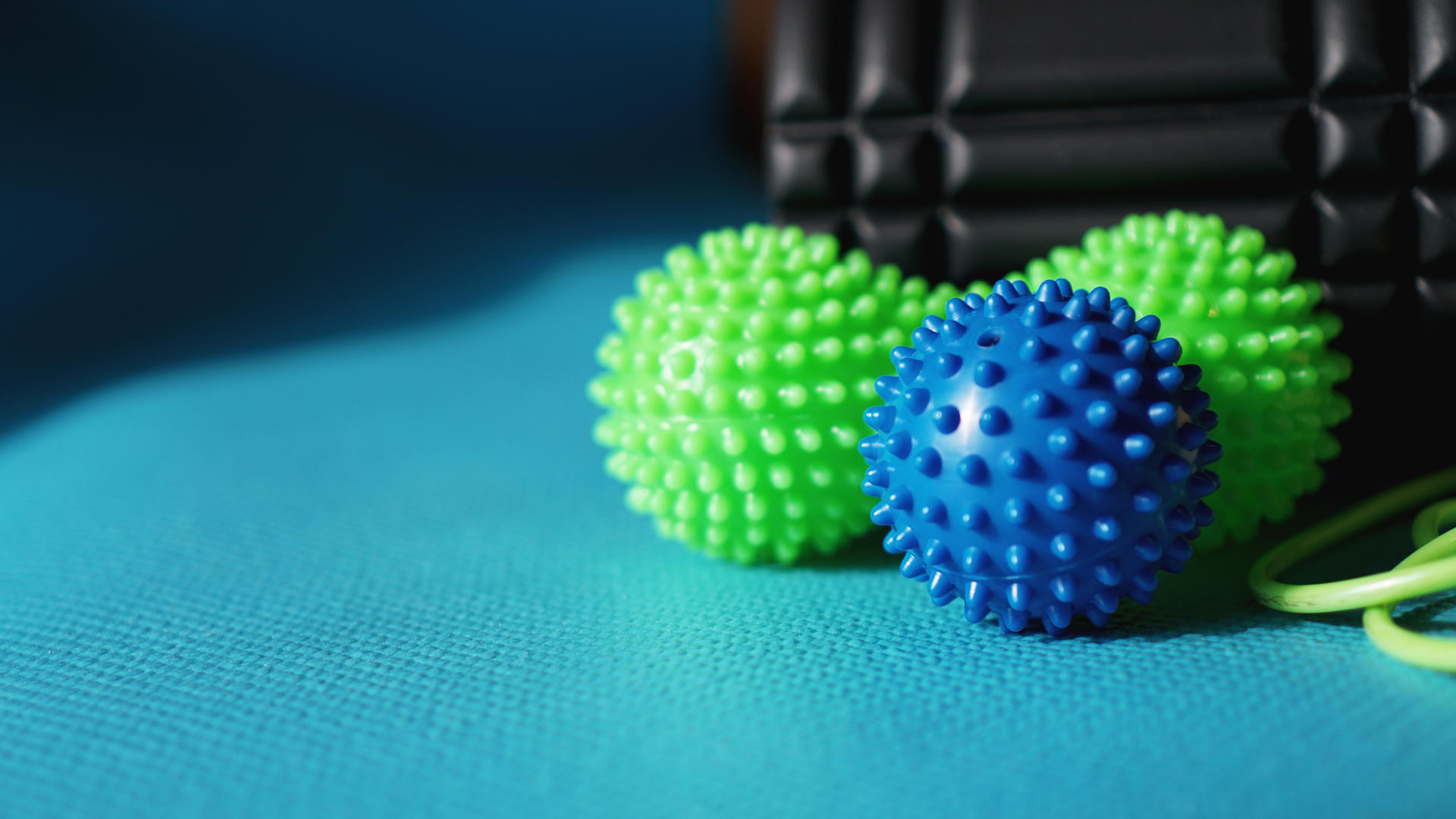
For example, using tools such as balls and nobblers aside from the usual foam rolling tools can make a much greater impact on trigger points themselves, rather than just aiding the top layer of the fascia in becoming more supple.
Foam rollers have a larger surface area, making it more difficult to target a problematic area with the muscle or the muscle fascia.
However, if the individual using SMR or the sports massage therapist that they’re seeing can locate the area that the trigger points are sitting within, the use of alternative SMR tools with a smaller surface area can help to target them.
Mobility balls are a great option for this, as they are able to reach smaller muscle groups and the trigger points within them, rather than just the larger areas of muscle. They are often equipped with spikes too, which can be incredibly beneficial when targeting more specific areas in the muscles and fascia.
It’s important to use a variety of tools for self-myofascial release therapy particularly when you’re looking to release trigger points.
While foam rollers are great for use on larger muscle areas and for preventing DOMS (delayed onset muscle soreness) which we’ll talk about later, they can sometimes overlook specific trigger points, so using them alongside other SMR tools is the best idea!
Start a Career in Sports Massage Therapy
#2 - Increases Blood Flow to Muscles & Fascia

When an injury is sustained, it’s natural that the affected areas of muscle suffer from reduced circulation. This is usually due to the trigger points or ‘knots’ within the muscles or the fascia acting as a blockage, and suppressing blood flow to the area.
This then causes increased muscle soreness and tension, which is exactly what self-myofascial release is setting out to avoid in the first place.
The benefits of foam rolling in self-myofascial release include the fact that this tool holds the ability to reverse the negative effects on blood circulation, and to improve blood flow to the injured areas. Since foam rollers cover a large area of muscle, they make a fantastic contribution to this alongside other SMR tools and techniques that focus on smaller muscle groups.
Through using a variety of self-myofascial release exercises, an individual can use SMR to improve their vascular function after an injury, which in turn reduces the overall pain or tightness that they experience.
To give an overview, good circulation levels naturally result in greater muscle health due to the larger number of nutrients being transported to the muscles. Waste products are also removed as part of the process, which also aids in reducing soreness.
From a boost in circulation, the injured muscle or fascia is able to heal faster than it would have done otherwise, meaning that an individual trying out SMR on a recent injury could be back on their feet much sooner as a result of using it!
NOTE: if you happen to be interested in becoming a sports massage therapist, you should be sure to check out our guide to Sports Massage Salary to find out more about how you can benefit from a career in this area!
Do You Want More Sports Massage Clients?
Download our guide and grow your base in 5 simple steps!
#3 - Improves Mobility & Flexibility

Both of the aspects above are important for all humans to maintain, and not just limited to professional athletes. If you partake in regular exercise or any form of competitive sports, you’ll already know what we’re talking about.
In case you didn’t already know, mobility relates to the ability of a joint to move through a range of motion, while flexibility relates to the same ability, but for muscles rather than joints.
While SMR can holistically improve the body’s range of motion with regular practice, it’s particularly effective for the areas affected by trigger points, which can dramatically hinder body movement.
This is because trigger points technically count as sections of muscle that are not being utilized during movement. By using mobility balls and more concentrated SMR tools, you can manipulate these trigger points into movement, and therefore increase and restore the mobility and flexibility of the injured area as a whole.
This statement from a study by G.Z. MacDonald et al (The Journal of Strength & Conditioning Research) on how self-myofascial release increases range of motion:
The data presented in this study suggests that an acute bout (only 2 minutes) of slow undulating foam rolling of the quadriceps on a high-pressure foam roller significantly increases quadriceps ROM.
In fact, foam rolling for only 2 minutes enhances quadriceps muscle ROM to a similar degree as previously reported in other static stretching studies.
The study states that self-myofascial release has the potential to increase an individual’s ROM without hindering their athletic performance, which is incredibly important for professional athletes to know, as well as those who participate in competitive sports.
One of the biggest self-myofascial release benefits compared to those of static and dynamic stretching techniques is that when tools such as foam rollers and mobility balls are used post-exercise, the healing process begins immediately.
Any pooled blood within the muscles is flushed out, meaning that the essential oxygen and nutrients needed to speed up recovery are able to reach the muscles almost instantly. This will prevent mobility and flexibility being hindered in the long-term after an injury, or temporarily once DOMS sets in, which leads us into…
#4 - Decreases the Risk of DOMS

It’s no secret that DOMS is one of the biggest turn offs when it comes to establishing a new fitness routine. There are always so many different reasons to give in, and DOMS happens to be one of the most popular excuses.
That’s why one of the biggest self-myofascial release benefits is that with regular practice, the occurrence of delayed onset muscle soreness can become almost non-existent.
You can learn more about this by reading our Sports Massage Therapy Aftercare article.
Foam rolling is probably one of the most effective SMR techniques for preventing DOMS since rollers typically have a much larger surface area than mobility balls, etc. and therefore cover a larger area of muscle. However, if you are prone to experiencing tightness in a more specific area, then you may also benefit from using alternative tools alongside a foam roller.
Aside from decreasing the risk of developing DOMS in the days after exercise, it can also be used to treat it after it's already set in, and to get the individual back to exercise considerably sooner than they would have been otherwise.
This is thanks to the fact that self-myofascial release flushes out the waste products that cause DOMS, and releases the trigger points that can even be caused by minor injuries and strains during exercise.
It can be used alongside dynamic stretching for this purpose, but beats this method by a mile due to its ability to actively target the problem areas.
How to Use Self-Myofascial Release
The first thing that you should establish when looking up how to do self-myofascial release is what your intentions or goals are. Ask yourself:
- Are you looking for a new way to warm-up?
- Are you looking for a way to prevent or heal DOMS?
- Are you injured and looking to reduce muscle soreness, as well as improving your mobility and flexibility?
- Do you have a chronic pain condition, such as myofascial pain syndrome?
As you’ve probably gathered from our list above, the way that you use SMR will depend on what you wish to achieve from it.
Using the information that we’ve put together throughout this article, we’ll let you use your own judgement.
As a rule of thumb, if you’re looking to target a problem area, you should use a mixture of tools and techniques to make SMR effective for your injury or chronic pain. However, if you're just looking to use self-myofascial release to prevent injury and exercise-induced pain, then you can try foam rolling as part of your usual warm up and cool down routines.
We’ll give you some holistic information on how self-myofascial release works, so that you can try out whichever method suits you best!
If you would like to learn more on this subject, you can learn interesting facts about Sports Massage Therapy.
Self-Myofascial Release Exercises
This routine can be done both pre and post-workout on a regular basis, so that you can reap all of the benefits of self-myofascial release. Depending on the physical activity that you’re going to be partaking in, you can adjust whether you focus on the upper or lower body accordingly.
So, if you're wondering how does self-myofascial release work?, here's your answer!
#1 - Calves
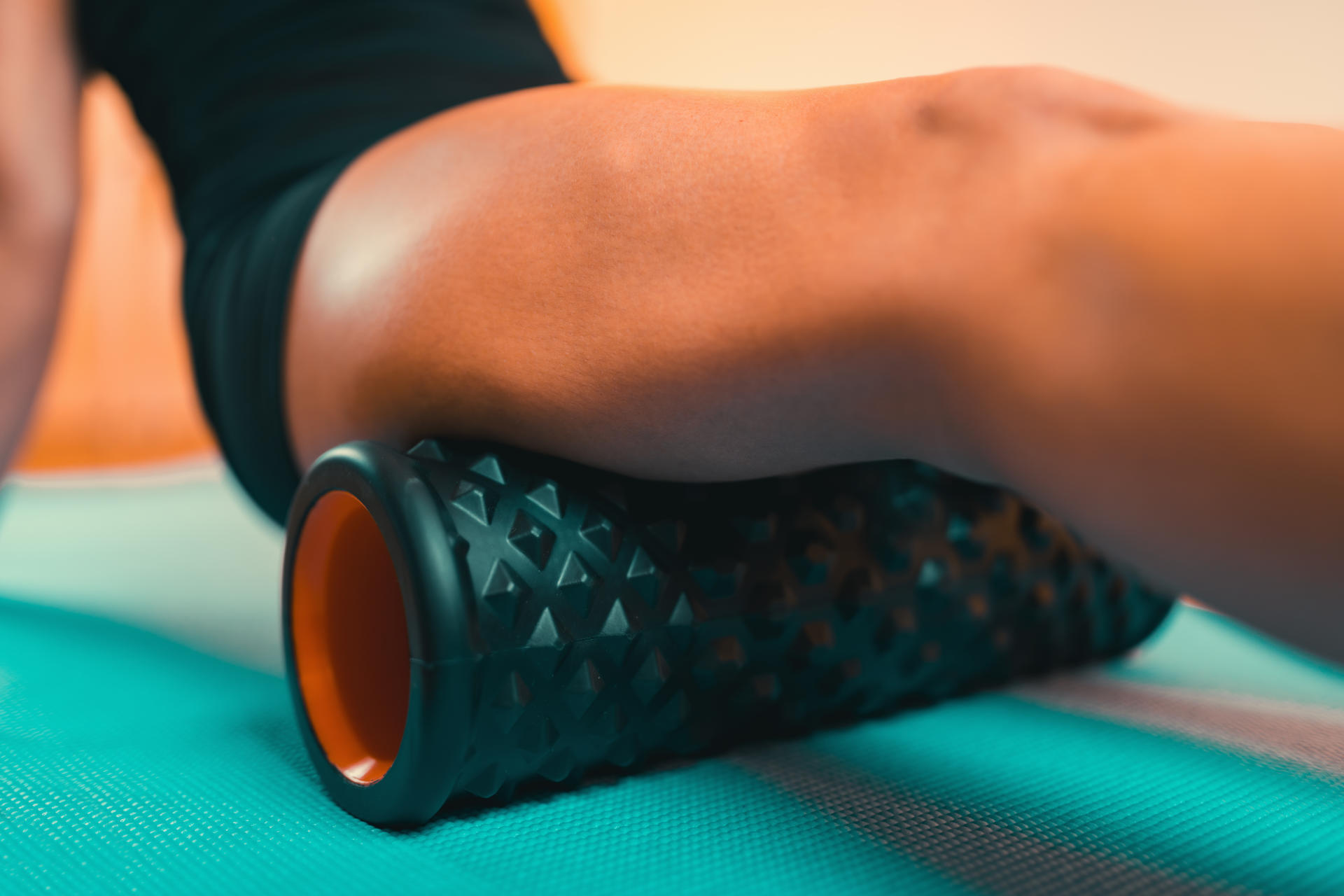
When you’re completing SMR, it’s a great idea to work from the bottom up so that you don’t miss out any of the major muscle groups. It’s also a great way of memorising the routine so that it soon becomes second nature!
The calves are a great place to start, especially since they involve such an easy position for foam rolling.
- Place the foam roller on the floor, and balance the area just above your ankles on top of it
- Have your hands just over shoulder-width apart, and use them to support your weight as you lift your glutes off the floor
- Slowly roll up to the top of your calves (just below the knee), and back down again
Once you’ve gotten the hang of this, you can try crossing one leg over the other and targeting one leg at a time. Feel free to rotate your calves as you roll too, so that you can feel the benefit in different areas!
Advance Your Career as a Sports Massage Therapist Continue developing your skills & knowledge with our Level 3 Sports Massage Course!
#2 - Hamstrings

Once you’ve rolled out your calves, the next stop should be the hamstrings. They’re often the subject of many muscle strains, but not for much longer if you stick to a regular self-myofascial release routine!
This movement is pretty similar to the way that you roll your calves, but you should start with one leg crossed over the other.
- Place the foam roller on the floor, and balance the area just above your knee on top of it
- Whilst supporting yourself with hands spread out at just over shoulder-width apart, and one leg crossed over the opposite, slowly roll up to the top of your legs (just below the glutes), and back down again
#3 - Quads
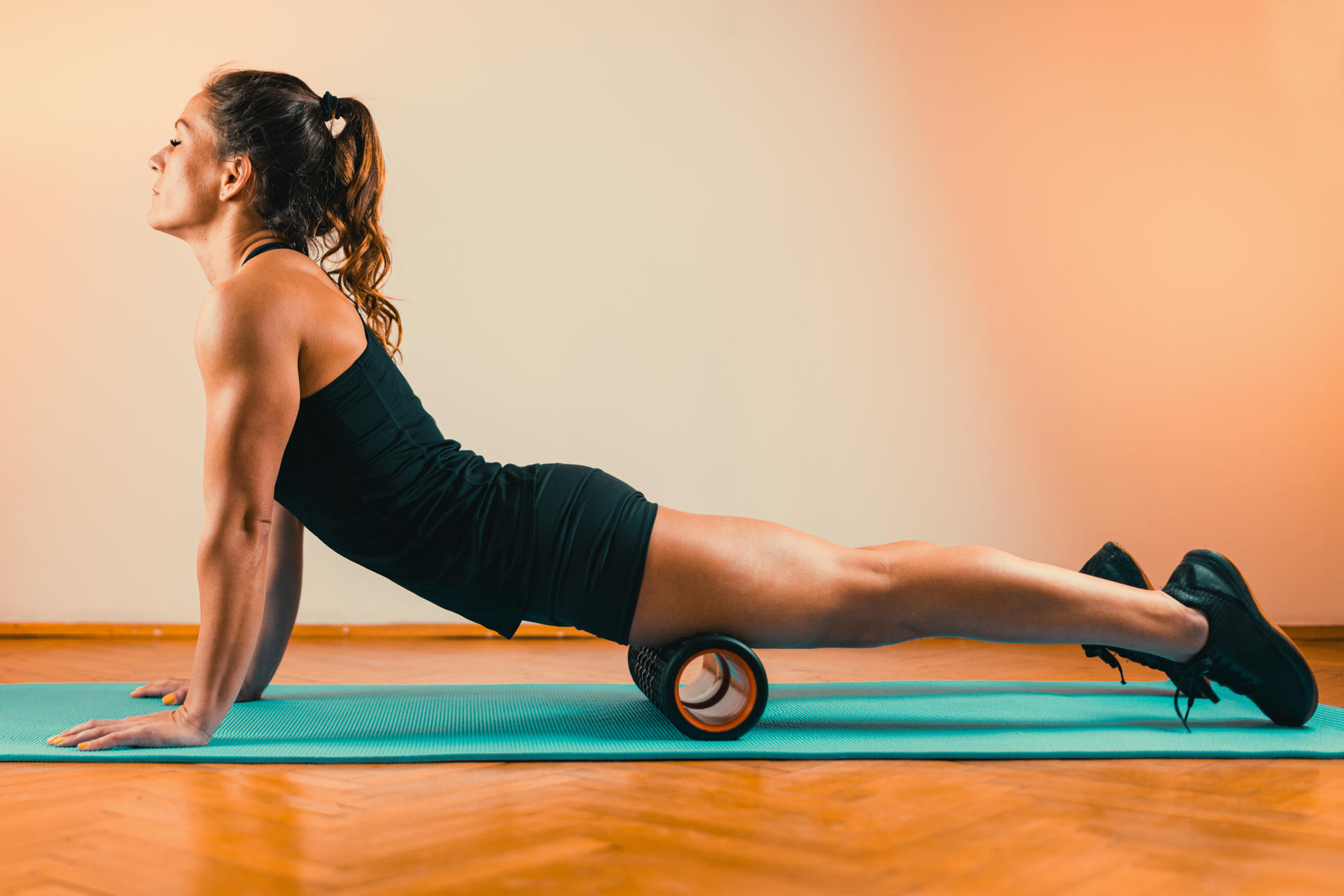
It’s time to roll over onto the front of your body for this move. You can use both legs at once, or cross them over to perform this move on one leg at a time; this will really help to target the trigger points within the quadriceps if you’re experiencing pain.
You should never miss out the quads when you come to perform your SMR routine, especially since they’re responsible for a great amount of mobility during competitive sports!
- Begin by lying on your front, with the foam roller placed underneath the area where your thigh begins (directly above your knee)
- Resting on your elbows, pull your body forwards to roll out your quads from the bottom up (stopping just before the pelvis), and then roll back again
#4 - Glutes
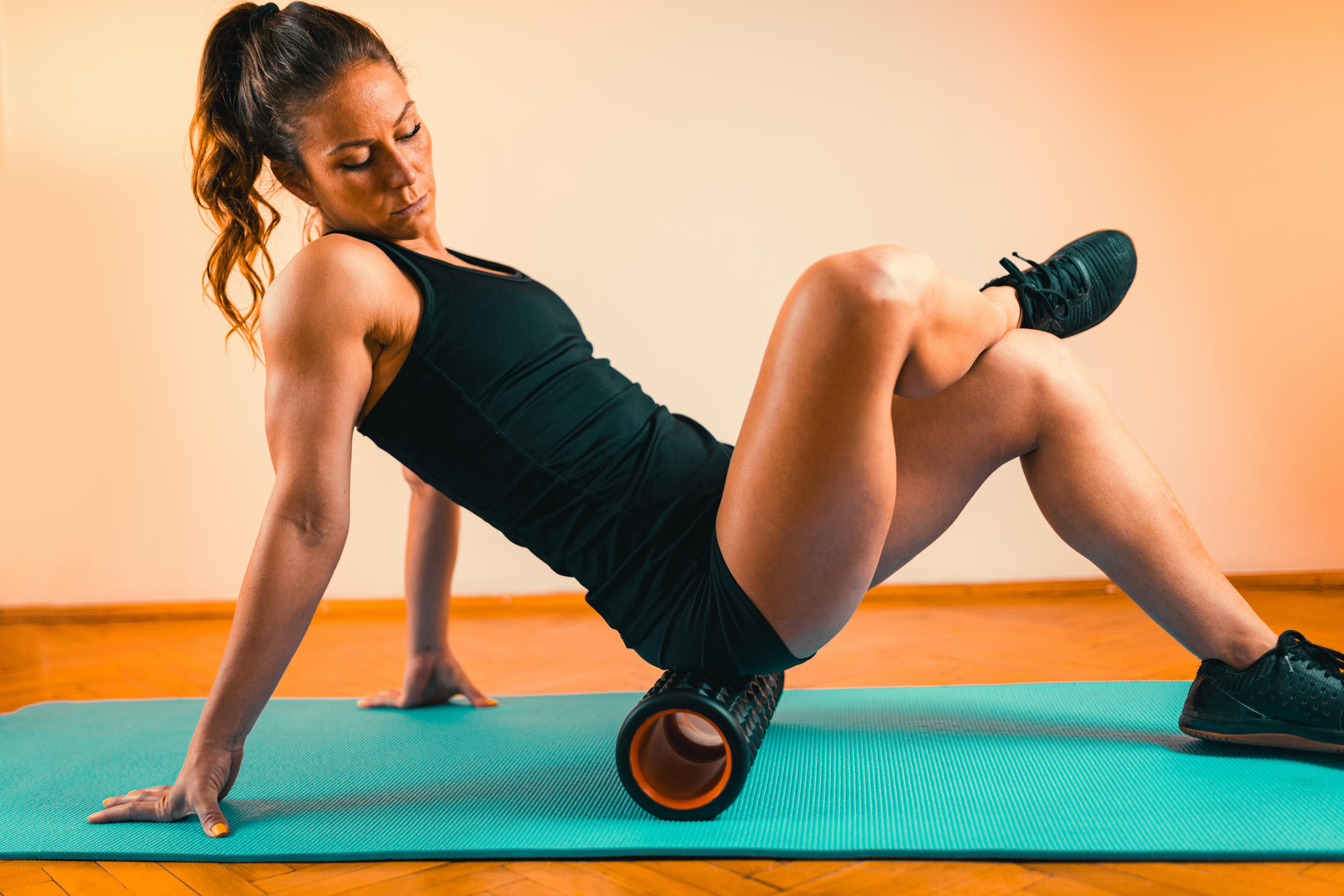
Now that you’ve rolled out most of the lower body, it’s time to shift focus onto the glutes. Most people overlook this muscle group in their warm-ups, especially if they haven’t yet had the misfortune of straining them, but you definitely shouldn’t!
- Begin by sitting on the foam roller, using your hands for support as you rest on them at just over shoulder-width apart
- Cross one leg over the other to ensure that the glutes are properly targeted
- Slowly roll up and down the muscle, and then roll out the opposite side
Once you’re used to performing the basic self-myofascial release exercises, you can switch out the foam roller for a mobility ball, or another tool that is focused on releasing trigger points.
By doing this, you’ll be able to feel the positive effects of the treatment in any areas that are feeling particularly tight, even more so once your muscles have already gotten used to the feel of the foam roller.
#5 - Iliotibial Band
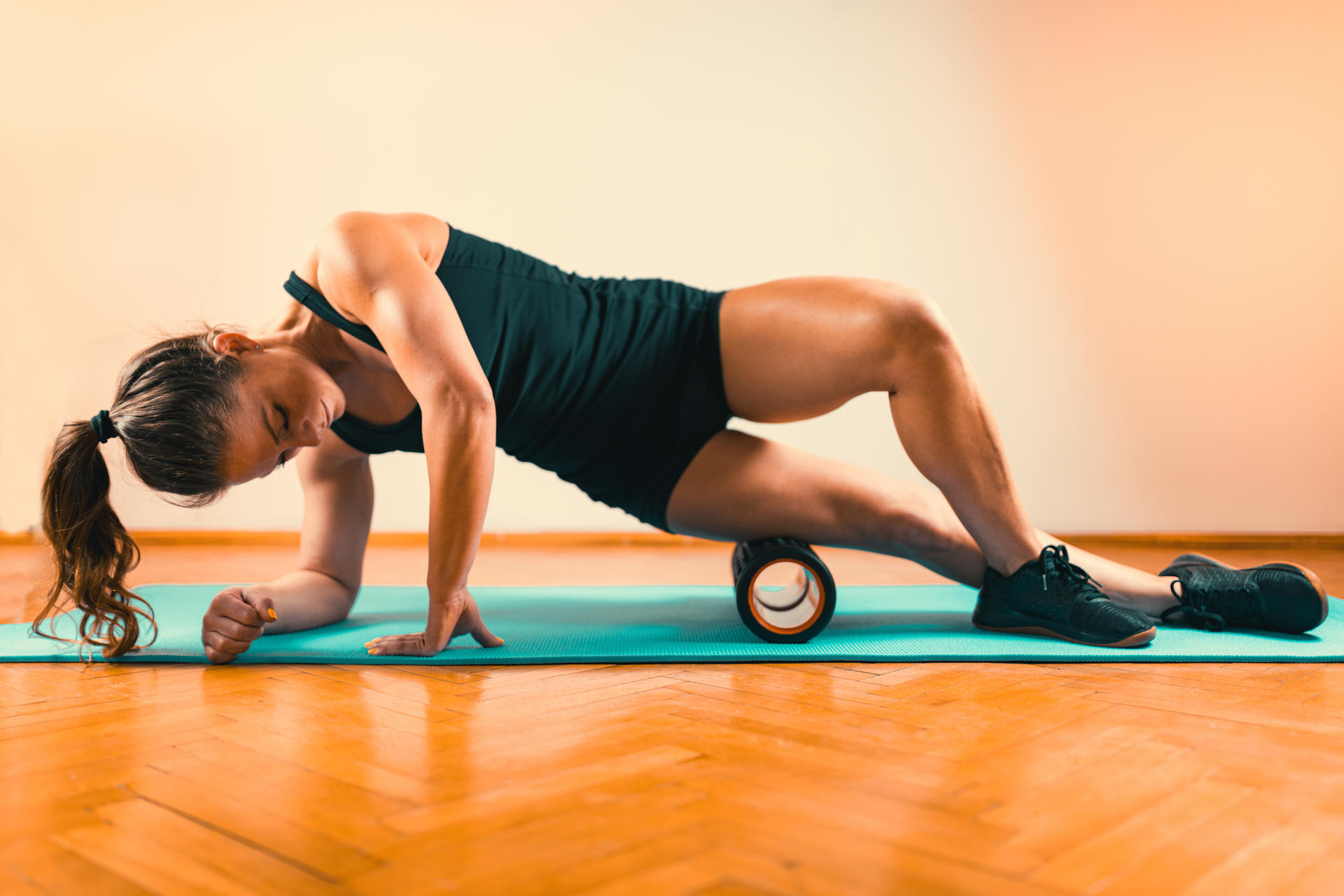
There are other lateral areas that benefit from the use of foam rolling, but the IT band (a thick fascial band attached to the knee) is one of the most commonly stretched during SMR. You should add it to your routine to decrease the risk of developing iliotibial band syndrome, another repetitive strain injury that occurs during exercise, and to avoid DOMS in the area.
- Start in a side plank position, resting your weight on the arm closest to the floor
- Have the foam roller placed under the area directly above your knee
- Slowly roll upwards towards the top of your leg, stopping just before you reach your hip, and then roll back again
Before You Go!
If you want to learn more about this topic, check out our Level 3 Sports Massage Course or download our prospectus for more information on what you could be learning.
After all, a career in physical therapy can be incredibly rewarding, as well as a great way to supplement your existing income!
References:
- Alvarez, D.J. and Rockwell, P.G., 2002. Trigger points: diagnosis and management. American family physician, 65(4), p.653.
- MacDonald, G.Z., Penney, M.D., Mullaley, M.E., Cuconato, A.L., Drake, C.D., Behm, D.G. and Button, D.C., 2013. An acute bout of self-myofascial release increases range of motion without a subsequent decrease in muscle activation or force. The Journal of Strength & Conditioning Research, 27(3), pp.812-821.
Do You Want More Sports Massage Clients?
Download our guide and grow your base in 5 simple steps!

